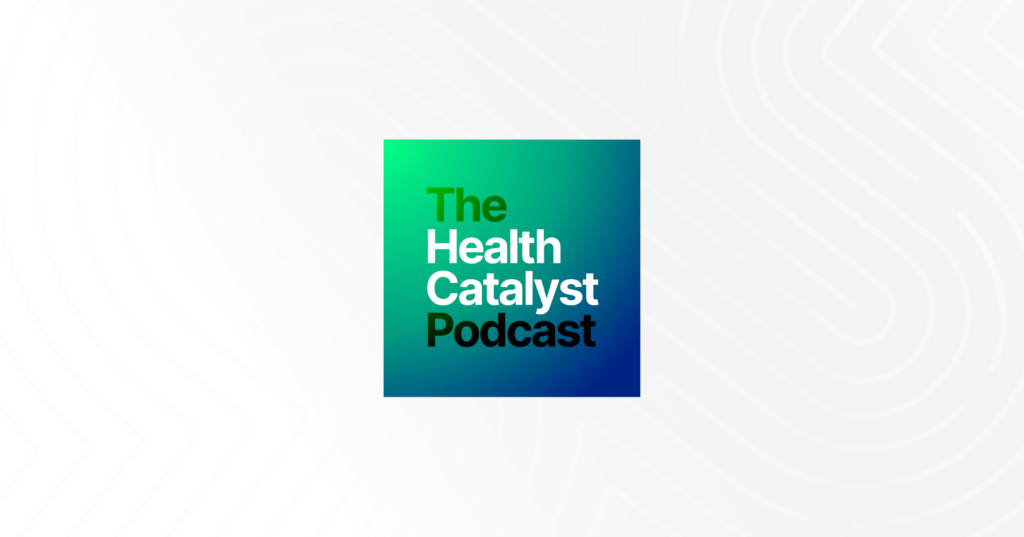Is healthcare data quality truly advancing, or are we simply drowning in an ocean of information? Healthcare organizations are collecting more data than ever before from wearables, electronic health records, and patient-reported outcomes. But is more data always better? The real challenge lies not in how much data we gather, but in how effectively we transform it into actionable insights. In the race to build accurate patient identities, we must ask: is there such a thing as too much information?
Striking the right balance between data volume and healthcare data quality is critical to driving healthcare forward. In a recent podcast, Rodrigo Hutt of Health Catalyst and Kristen Valdes, CEO and Founder of b.well Connected Health, explored these critical issues, focusing on the importance of identity management and shifting from data overload to actionable information. Mastering how we manage identity while filtering through mountains of data will be key to delivering truly effective, high-quality care.
The Importance of Identity in Healthcare
Identity plays a foundational role in healthcare delivery. Accurately connecting patients to their medical records and ensuring that healthcare providers have the right information is crucial for effective treatment. The challenge lies in collecting and managing this information efficiently. Traditional methods often involve cumbersome forms that can frustrate patients and lead to incomplete data collection.
Healthcare organizations must streamline identity verification processes to ensure they capture essential data without overwhelming patients. A robust identity management system is not just about collecting information; it’s about understanding who the patient is, their history, and their specific healthcare needs. This means integrating multiple data points, from demographic information to previous medical encounters, into a coherent patient profile, or longitudinal health record, that healthcare providers can rely on.
As Kristen Valdes explains, “There are two main types of data exchange today. We believe the advancement of IAL2-level identity verification, provided by organizations like CLEAR, which ensures individuals are accurately identified through biometrics and other personal information, will strengthen the trust network. This means when data is requested on behalf of an individual, we can be confident that the correct information is being retrieved. As a result, individuals can access their longitudinal health records and take them wherever they go, whether they’re seeing a new doctor, seeking a second opinion, or relocating.”
In the end, healthcare’s ability to provide personalized, effective care hinges on ensuring the right data follows the right person throughout their care journey. By leveraging advancements in identity verification, the healthcare industry can empower patients with more control over their health data, improving continuity of care and driving better outcomes.
The Role of Smart Data in Modern Healthcare
The exponential growth of health data from various sources, such as electronic health records (EHRs), wearables, and patient-reported outcomes, challenges organizations to consider the point at which data becomes overwhelming rather than beneficial. While the demand for data continues to rise, it’s essential to shift the focus from sheer volume to the quality and actionability of the information collected. Rather than simply accumulating vast amounts of data, the emphasis should be on curating and synthesizing that information into meaningful impactful information. These insights can empower healthcare professionals to make informed decisions, ultimately enhancing patient care and operational efficiency.
“While there are many different kinds of data you can pull in, they often come in different formats. It’s a lot of work to standardize and normalize that data, but the goal is to access someone’s entire longitudinal health data—both inside and outside of traditional medical settings. With more electronics companies embedding sensors in devices like refrigerators, air purifiers, and even voice assistants like Alexa and Siri, we’re seeing a shift toward capturing health-related data in the home. All of this data impacts health in some way, and with the implementation of FHIR and Open Standard Implementation Guides, it’s becoming much easier to bring it all together,” states Kristen.
In this context, the concept of “smart data” emerges as a crucial framework. Smart data prioritizes useful findings over information overload, ensuring that healthcare providers have access to relevant and timely data that can inform their decisions. By leveraging quality data and focusing on what truly matters, healthcare organizations can navigate the complexities of data management while maximizing the impact on patient outcomes.
How Smart Data Works
Smart data transforms the vast amounts of information generated in healthcare into meaningful insights that can drive effective decision-making. Here’s a breakdown of how smart data operates:
1. Data Collection and Integration
Smart data begins with the collection of diverse data types from multiple sources, including:
- Electronic Health Records (EHRs): Captures patient history, medications, and treatment outcomes.
- Wearable Devices: Gathers real-time health metrics like heart rate and activity levels.
- Patient-Reported Outcomes: Includes surveys and feedback directly from patients about their health experiences.
Integrating these data streams into a centralized system is crucial. Advanced data integration platforms help consolidate and standardize information from disparate sources, creating a comprehensive patient profile.
2. Data Cleansing and Normalization
To ensure accuracy and usability, raw data must be cleansed and normalized. This process involves:
- Removing Duplicates: Ensuring that patient records are not duplicated across different systems.
- Standardizing Formats: Converting data into a consistent format (e.g., date formats, terminology) to facilitate analysis.
- Identity and Data Linking/Matching: Ensuring accurate integration of patient data from multiple sources for a comprehensive and unified view.
Cleansed data is more reliable, reducing the risk of errors in healthcare decisions.
3. Advanced Analytics and Machine Learning
Once data is integrated and cleaned, advanced analytics techniques come into play:
- Predictive Analytics: Using historical data to identify trends and predict future outcomes (e.g., risk of hospitalization).
- Natural Language Processing (NLP): Analyzing unstructured data, such as clinical notes, to extract relevant takeaways.
- Machine Learning Algorithms: Training models to recognize patterns and make recommendations based on the data.
These analytical tools help identify result-driven insights from the data, enabling healthcare providers to make informed decisions.
4. Contextualization and Personalization
Smart data takes into account the context of each patient’s situation:
- Personalization: Tailoring treatment plans based on individual patient data, preferences, and circumstances.
- Contextual Insights: Providing healthcare providers with relevant information during patient interactions, such as alerts for potential drug interactions or reminders for preventive care.
This approach enhances the relevance and applicability of the data in clinical settings.
5. Actionable Outputs
The ultimate goal of smart data is to generate actionable outputs that healthcare professionals can use:
- Dashboards and Reports: Visual representations of key metrics that highlight important patient information.
- Clinical Decision Support Systems (CDSS): Tools that provide real-time recommendations based on data analysis, helping clinicians make better decisions.
- AI Model Enhancement: Cleansed data feeds into AI models, enhancing their accuracy and predictive capabilities for improved healthcare insights.
These outputs ensure that the insights derived from the data translate into tangible actions that improve patient care.
6. Continuous Feedback Loop
Smart data operates within a continuous feedback loop:
- Monitoring Outcomes: After implementing changes based on data insights, healthcare providers can monitor patient outcomes to assess effectiveness.
- Iterative Improvement: Using feedback to refine data collection methods, analytics models, and care processes, continuously enhancing the smart data system.
This loop fosters a culture of continuous improvement in healthcare delivery.
Smart data empowers healthcare organizations to harness information effectively, turning it into usable insights that enhance patient care and operational efficiency. By integrating diverse data sources, employing advanced analytics, and focusing on personalization, smart data creates a more responsive and effective healthcare environment with healthcare data quality.
Healthcare Data Quality with Actionable Information
Actionable information is data that can inform decisions, guide treatment plans, and enhance patient engagement. For instance, if a healthcare provider can access a comprehensive overview of a patient’s medical history, including medications, allergies, and past treatments, they are better equipped to provide personalized care. However, this requires a shift in how data is collected and utilized.
Healthcare organizations must prioritize creating systems that filter out noise and highlight the most relevant information. This means investing in technologies that can analyze and synthesize data effectively, ensuring that providers receive the insights they need without being inundated by irrelevant details.
Finding the Balance
To build a robust healthcare data quality management system in healthcare, organizations must focus on two key components: effective data collection and intelligent data usage. As the industry continues to embrace digital health innovations, healthcare data quality must remain a top priority to avoid the pitfalls of information overload. Smart data, transforming raw data into impactful information, offers a pathway forward. By focusing on integration, cleansing, and analytics, healthcare providers can access the right information at the right time, enhancing patient care and operational efficiency. Ultimately, high-quality data will empower better decision-making, leading to improved outcomes and a more effective healthcare system.
In an era where data is abundant, the ability to harness it effectively will determine the future of healthcare delivery. By focusing on the quality and relevance of information, healthcare organizations can drive better outcomes, streamline operations, and shape the future of effective care delivery.



